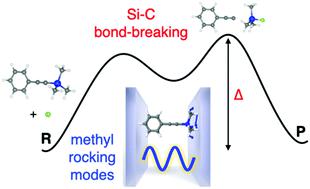当前位置:
X-MOL 学术
›
Phys. Chem. Chem. Phys.
›
论文详情
Our official English website, www.x-mol.net, welcomes your
feedback! (Note: you will need to create a separate account there.)
On the SN2 reactions modified in vibrational strong coupling experiments: reaction mechanisms and vibrational mode assignments
Physical Chemistry Chemical Physics ( IF 2.9 ) Pub Date : 2020-09-07 , DOI: 10.1039/d0cp04154h Clàudia Climent 1, 2, 3, 4 , Johannes Feist 1, 2, 3, 4
Physical Chemistry Chemical Physics ( IF 2.9 ) Pub Date : 2020-09-07 , DOI: 10.1039/d0cp04154h Clàudia Climent 1, 2, 3, 4 , Johannes Feist 1, 2, 3, 4
Affiliation

|
Recent experiments have reported modified chemical reactivity under vibrational strong coupling (VSC) in microfluidic Fabry–Pérot cavities. In particular, the reaction rate of nucleophilic substitution reactions at silicon centers (SN2@Si) has been altered when a vibrational mode of the reactant was coupled to a confined light mode in the strong coupling regime. In this situation, hybrid light–matter states known as polaritons are formed and seem to be responsible for the modified chemical kinetics. These results are very encouraging for future applications of polaritonic chemistry to catalyze chemical reactions, with the ability to manipulate chemical phenomena without any external excitation of the system. Still, there is no theory capable of explaining the mechanism behind these results. In this work we address two points that are crucial for the interpretation of these experiments. Firstly, by means of electronic structure calculations we report the reaction mechanism in normal conditions of the two recently modified SN2@Si reactions, obtaining in both cases a triple-well PES where the rate-determining step is due to the Si–C and Si–O bond cleavage. Secondly, we characterize in detail the normal modes of vibration of the reactants. In the VSC experiments, reaction rates were modified only when specific vibrations of the reactants were coupled to a cavity mode. We find that these vibrations are highly mixed among the different fragments of the reactants leading to a completely new assignment of the IR peaks coupled to cavity modes in the original experimental works. Our results are fundamental for the interpretation of the VSC experiments given that in the absence of a theory explaining these results, the current phenomenological understanding relies on the assignment of the character of the vibrational IR peaks.
中文翻译:

关于振动强耦合实验中修饰的SN2反应:反应机理和振动模式分配
最近的实验报告了在微流体法布里-珀罗腔中在振动强耦合(VSC)下的化学反应性得到了改善。特别是硅中心的亲核取代反应的反应速率(S N当在强耦合状态下将反应物的振动模式耦合到受限光模式时,已经改变了2(Si)。在这种情况下,形成了称为极化子的混合光-物质态,似乎是导致化学动力学改变的原因。这些结果对于极化离子化学在催化化学反应方面的未来应用非常令人鼓舞,它具有在不引起系统任何外部激励的情况下操纵化学现象的能力。仍然没有理论能够解释这些结果背后的机制。在这项工作中,我们解决了对解释这些实验至关重要的两点。首先,通过电子结构计算,我们报告了两个最近修饰的S N在正常条件下的反应机理2 @ Si反应,在两种情况下均获得三孔PES,其中速率确定步骤是由于Si-C和Si-O键的裂解。其次,我们详细描述了反应物振动的正常模式。在VSC实验中,仅当反应物的特定振动耦合到腔模时,才改变反应速率。我们发现,这些振动在反应物的不同片段之间高度混合,从而在原始实验工作中导致了与腔模耦合的IR峰的全新分配。我们的结果是解释VSC实验的基础,因为在没有理论解释这些结果的情况下,当前的现象学理解依赖于振动IR峰特征的分配。
更新日期:2020-10-17
中文翻译:

关于振动强耦合实验中修饰的SN2反应:反应机理和振动模式分配
最近的实验报告了在微流体法布里-珀罗腔中在振动强耦合(VSC)下的化学反应性得到了改善。特别是硅中心的亲核取代反应的反应速率(S N当在强耦合状态下将反应物的振动模式耦合到受限光模式时,已经改变了2(Si)。在这种情况下,形成了称为极化子的混合光-物质态,似乎是导致化学动力学改变的原因。这些结果对于极化离子化学在催化化学反应方面的未来应用非常令人鼓舞,它具有在不引起系统任何外部激励的情况下操纵化学现象的能力。仍然没有理论能够解释这些结果背后的机制。在这项工作中,我们解决了对解释这些实验至关重要的两点。首先,通过电子结构计算,我们报告了两个最近修饰的S N在正常条件下的反应机理2 @ Si反应,在两种情况下均获得三孔PES,其中速率确定步骤是由于Si-C和Si-O键的裂解。其次,我们详细描述了反应物振动的正常模式。在VSC实验中,仅当反应物的特定振动耦合到腔模时,才改变反应速率。我们发现,这些振动在反应物的不同片段之间高度混合,从而在原始实验工作中导致了与腔模耦合的IR峰的全新分配。我们的结果是解释VSC实验的基础,因为在没有理论解释这些结果的情况下,当前的现象学理解依赖于振动IR峰特征的分配。










































 京公网安备 11010802027423号
京公网安备 11010802027423号